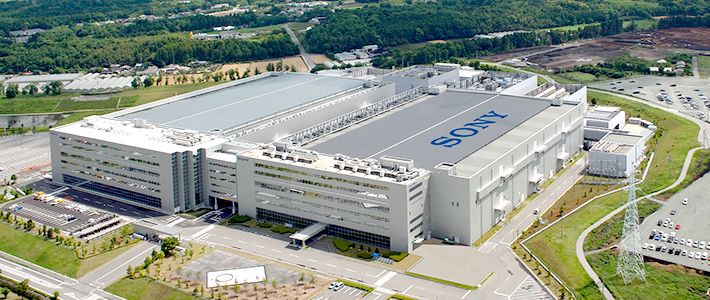
Sony High-Tech Plant Prepares for the Next Big One
Economy- English
- 日本語
- 简体字
- 繁體字
- Français
- Español
- العربية
- Русский
Continuity in Business Is the Key
Following the April 2016 Kumamoto earthquakes, including a temblor that topped magnitude 7, production at a Sony subsidiary’s plant in the prefecture halted for three and a half months. The facility, owned by Sony Semiconductor Manufacturing, makes image sensors for digital cameras and smartphones. As the disaster cut off the supply of these essential components, it affected a number of electronic equipment manufacturers downstream in the value chain.
The company has responded in the year since by making reinforcements to plant buildings where urgently required, increasing the quake resistance of plant piping, and reviewing initial response procedures. It will continue to work on earthquake resistance measures for two more years.
Company president Suzuki Hiromi says, “Even if another earthquake of the same strength takes place, we have made preparations allowing us to restart production in two months. We won’t inconvenience customers.” As the company now maintains a two-month supply of produced parts, ready for distribution, this break in production would not impact its business.
A Warning That Came Too Late
A semiconductor production line features many expensive precision instruments. Equipment for printing miniature circuits on silicon wafers is particularly important. During seismic shaking, the high-performance lenses that reflect laser light onto the wafers may be destroyed, along with the wafers themselves. Repairs take time and are very expensive. However, if the company can shut down production lines as quickly as possible after shaking begins (or ideally, before the shaking even arrives) it can minimize plant damage.
In the case of earthquakes striking directly under an affected area, as in Kumamoto, there is little time between the primary and secondary waves (P-waves and S-waves). This makes the Japan Meteorological Agency’s early warning system—which uses seismometers in over 1,000 locations nationwide to detect the fast-traveling P-waves, estimate the hypocenter and scale of the earthquake, and predict the seismic intensity in different areas before the more destructive S-waves arrive—less useful in places situated directly above a fault.
The first of the Kumamoto earthquakes took place at 9:26 pm on April 14, 2016. A Japan Meteorological Agency seismometer in the prefecture detected P-waves 4.3 seconds after tremors began, and an earthquake warning was sent out after 8.1 seconds.
However, Sony’s Kumamoto plant was hit by S-waves 5.5 seconds after the earthquake started. In other words, the plant was affected by major shaking before receiving the warning, and there was no time to stop the production line.
Relying on JMA warnings alone is therefore not enough to protect the plant. Sony decided it needed its own warning system in place.
Priceless Seconds
Sony has now introduced a system developed in collaboration with Tokyo-based tech venture firm Mieruka Bōsai. This fiscal year, Sony is installing three seismometers in the grounds of the Kumamoto plant and using the Mieruka Bōsai system and JMA data to issue rapid warnings to the plant before major tremors begin.
The goal of this system is to ensure a two-second warning before S-waves arrive, in the case of an earthquake of the same scale as last year. If the system succeeds, the priceless seconds could be used to safely shut down the production line.
Installing seismometers in nearby plants, building a network, and sharing data would increase the speed of detection and the accuracy of warnings. Sony is encouraging other companies in the prefecture to install their own seismometers. It also plans to make the devices part of its plants in nearby Nagasaki, Ōita, and Kagoshima Prefectures.
The Lessons of Kumamoto
Nittō Denkō is another Japanese company with a Mieruka Bōsai warning system in place, installed in 2015. Like Sony, it aims to minimize damage by shutting down the production line before destructive shaking from a predicted Tōnankai earthquake reaches its site in Toyohashi, Aichi Prefecture.
Sony shared extensive details of its business continuity plan review with the Japan Electronics and Information Technology Industries Association, allowing other companies to draw on its experience. “Some things happened that we could not have predicted until they actually took place. We learned many lessons,” Suzuki said.
For example, the company now recommends that employees carry their wallets, purses, and home and car keys with them at all times. Many of the production line workers previously stored them in the locker room after changing into their uniforms. If an earthquake takes place, lockers may fall over and the room itself might be rendered inaccessible, leaving the workers stranded without money and unable to drive to or get into their homes.
Sony also requested changes to industry guidelines on the use of clean rooms, necessary for delicate silicon fabrication, after earthquakes. These mandated that clean rooms could only be reopened for work after the possibility of aftershocks of seismic intensity 5 or higher dropped below 10%. This was too strict, noted Sony, meaning that no work could be done.
As well as cost competition from emerging countries, Japan’s high-tech plants face the ever-present risk of natural disaster. Suzuki says, “It’s impossible to prevent earthquakes from taking place, but by making preparations to ensure rapid recovery, I want to boost our international competitiveness.”
(Originally published in Japanese on August 16, 2017. Banner photo: The Kumamoto plant of Sony Semiconductor Manufacturing.)